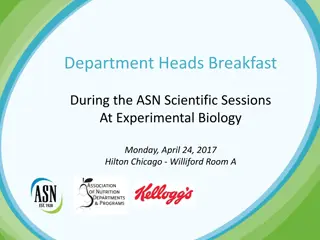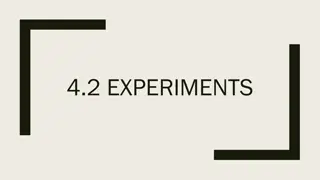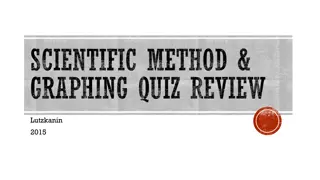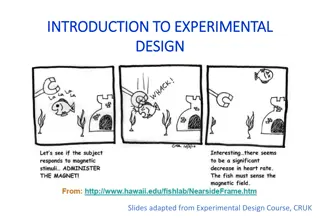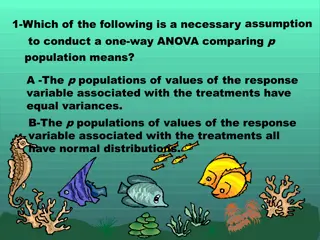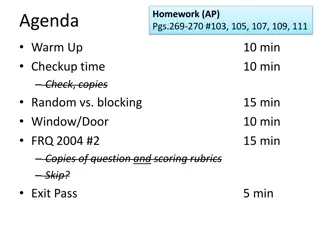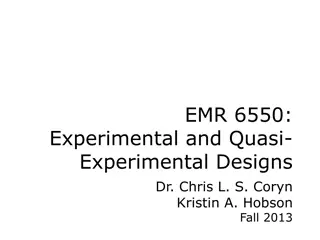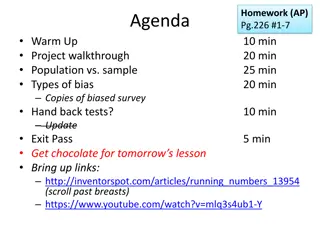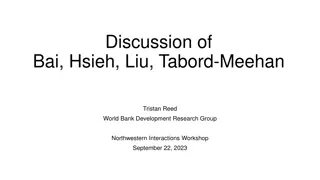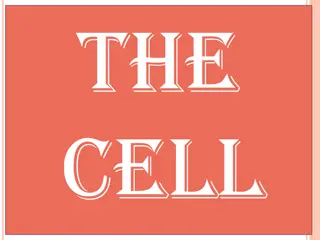Understanding Experimental Design in Biology
Explore key concepts in experimental design in biology through clicker questions focusing on hypotheses, variables, control groups, and experimental groups. Learn how scientists test hypotheses and analyze results to draw valid conclusions in biological studies.
Download Presentation

Please find below an Image/Link to download the presentation.
The content on the website is provided AS IS for your information and personal use only. It may not be sold, licensed, or shared on other websites without obtaining consent from the author. Download presentation by click this link. If you encounter any issues during the download, it is possible that the publisher has removed the file from their server.
E N D
Presentation Transcript
Biology for a Changing World, 2e Clicker Questions Chapter 1
Scientists solely rely upon anecdotal evidence to test hypotheses. A. True B. False
Cats love fish more than dogs love fish. A. This is a hypothesis. B. This is a theory. C. This is not a hypothesis because it is not testable. D. This is not a hypothesis because it is not written using the if/then format.
Evaluate the following: Bernice observed that when she supplemented her watering regime with a particular brand of fertilizer, A , her plants seemed to grow taller. She thought to herself, Brand A fertilizer is causing my plants to grow taller. Bernice collected 20 plants. She supplemented the normal watering regime of 10 plants with fertilizer A. The remaining ten plants received the normal watering regime without the fertilizer supplement. After two months, she determined the average plant height for each group of plants.
What is the independent variable? A. The 20 plants B. Fertilizer C. Plant height D. The watering regime
What is the dependent variable? A. The 20 plants B. Fertilizer C. Plant height D. The watering regime
Evaluate the following: Bernice observed that when she supplemented her watering regime with a particular brand of fertilizer, A , her plants seemed to grow taller. She thought to herself, Brand A fertilizer is causing my plants to grow taller. Bernice collected 20 plants. She supplemented the normal watering regime of 10 plants with fertilizer A. The remaining ten plants received the normal watering regime without the fertilizer supplement. After two months, she determined the average plant height for each group of plants.
What is the control group in Bernices investigation? A. The normal watering regime with fertilizer A. B. The normal watering regime without a fertilizer supplement. C. The watering regime. D. The control is that she treated all of the plants the same, with the exception of the fertilizer treatment.
What is the experimental group in Bernices investigation? A. The normal watering regime with fertilizer A. B. The normal watering regime without a fertilizer supplement. C. The watering regime. D. The control is that she treated all of the plants the same, with the exception of the fertilizer treatment.
Evaluate the following: Bernice observed that when she supplemented her watering regime with a particular brand of fertilizer, A , her plants seemed to grow taller. She thought to herself, Brand A fertilizer is causing my plants to grow taller. Bernice collected 20 plants. She supplemented the normal watering regime of 10 plants with fertilizer A. The remaining ten plants received the normal watering regime without the fertilizer supplement. After two months, she determined the average plant height for each group of plants.
Bernices investigation is an example of a controlled experiment because A. It is not a controlled experiment because some plants received a fertilizer supplement and others did not. B. she used 20 plants. C. ten plants received a fertilizer treatment and the other ten did not. D. she treated all of the plants the same, with the exception of the fertilizer treatment.
When interpreting experimental results scientists A. compare values and if one value is larger than another, the scientist concludes that a significant difference occurred. B. conduct statistical analysis to determine if the obtained results were real and not due to chance. C. use data that only support their hypothesis. D. None of the above
When it comes to experimental design and confidence in data, a larger sample size is always better. A. True B. False
A theory is A. mere conjecture. B. a speculative idea or plan as to how something might be done. C. a widely accepted explanatory idea that is broad in scope and supported by a large body of evidence gathered through multiple tests of hypotheses. D. an explanation for natural phenomena that is testable.
Drinking coffee is associated with a lower risk of Parkinson disease. This statement is an example of A. correlation. B. causation.












